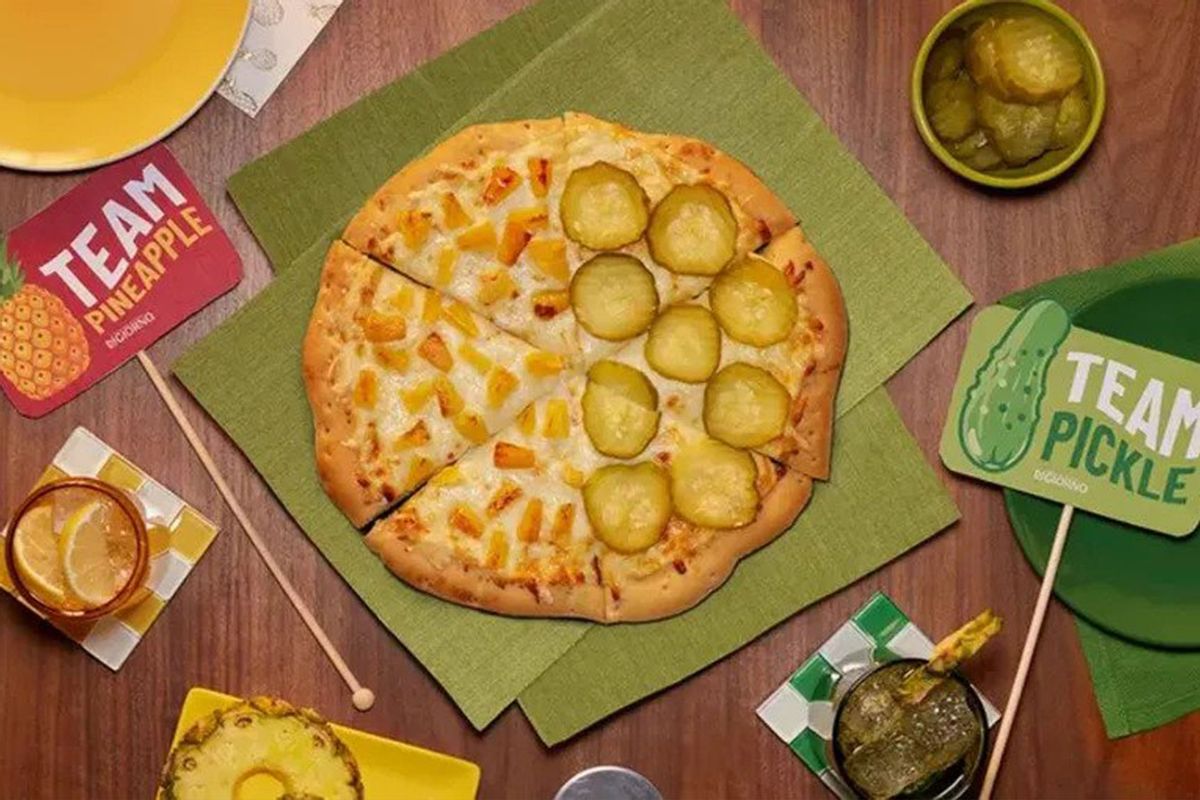Pineapple, pickles and polarizing toppings: How a crowded freezer aisle is inspiring “stunt pizzas”

When I saw a picture of DiGiorno’s pineapple and pickle pizza, my first thought was that it is essentially a lab-constructed stunt pie, a half-and-half amalgam of two of the more universally polarizing pizza toppings meant to, as Food & Wine put it, “enrage the entire internet.”
To an extent, the roll-out of the product supports this theory, as it won’t actually be available in stores. Instead, starting in September, DiGiorno will give customers an opportunity to receive one free frozen pineapple and pickle pizza online during weekly drops. Per Food & Wine, the pies will be limited to one per person, reminiscent of other splashy product drops like Old Bay Vodka and Taco Bell’s Jalapeño Noir — items that absolutely dominated social media, but which very few customers actually tried.
However, in a competitive landscape, you’ve got to find ways to stick out. After all, the world of pizza is a crowded one.
There are over 78,000 pizza shops in the United States (1,900 of which are in New York, while Chicago has over 800) slinging dough and baking pies, which is an increase of 2.3% over last year. However, as Food Business reported, the frozen pizza industry — of which DiGiorno has long been a leader — is growing increasingly competitive, too.
According to a 2022 report from Mintel, an independent market analysis company, sales of retail pizza (which includes frozen pizza, refrigerated take-and-bakes and pizza kits) saw a 24% surge in sales during the first year of the pandemic in 2020. They spiked again in 2022 as Americans sought easy, cheap dinners during a period of profound inflation.
In the frozen aisle, the numbers continue to climb. According to Circana data collected by Food Business News, “frozen pizza sales rose 10.2% to nearly $6.9 billion while units slipped 3.1%” and the “average price per unit jumped 13.7%, more than making up for any unit decline.”
Seniority and convenience isn’t necessarily enough to secure a top spot in the freezer case, especially in the coming years.
Sally Lyons Wyatt, the executive vice president and practice leader for client insights at Circana told the publication: “When you think about a 10% increase and losing 3% in unit sales, that’s incredible. It shows that pizza still has staying power for the category in the stores.”
She points to convenience as a driving factor in the growth. “Consumers have it in a freezer in their own homes, and they can get it when they want it and bake it when they want it,” Lyons Wyatt said.
In the realm of at-home pizza, DiGiorno is something of a veteran; in 1995, Kraft released the DiGiorno brand of products (along with its now-iconic slogan, “It’s not delivery, it’s DiGiorno”). The crust actually rose during baking, unlike many of the thin-crust options that dominated the market at the time.
But seniority and convenience isn’t necessarily enough to secure a top spot in the freezer case, especially in the coming years. According to new data from the London-based market research company Technavio, the global frozen pizza market is expected to grow by nearly $650 million from 2022 to 2027.
As the category expands, we’re starting to see more range in frozen pizza offerings. You’ve got premium, gourmet-quality pies like those from Roberta’s, Table 87, Talia di Napoli and Genio Della Pizza, which are all available at supermarkets nationwide (and which were all favorably reviewed earlier this year by the New York Times food team). Digital marketplaces like Goldbelly make it easy for home cooks to order specialty pizzas directly from local makers, and fan-favorite supermarket chains, like Trader Joe’s and Aldi, continue to expand their frozen pizza selections.
Of course it makes sense that DiGiorno wants to draw attention back to their corner of the freezer case, and what better way than to create an item that will get everyone talking?
Pineapple has been a contentious topping since it was first put on pizza by a Greek immigrant living in Canada named Sam Panopoulos in 1962. Pickle pizza is a relatively newer trend, though it is now a “big dill,” as the Washington Post reported in 2022.
“It’s a new food item this year at the Minnesota and Indiana state fairs, and announcements about it have attracted attention from local media and social media oglers,” wrote the Post’s Emily Heil. “Pickles have been popping up among more traditional offerings in pizza shops, too, from chain joints to cheffy pizzerias. Most often served atop a white or ranch sauce instead of the classic red, pickles are proving that they’re more than a novelty act in the pizza-topping game.”
Personally, I’m not opposed to either topping. I was swayed in favor of pineapple after tasting pizza maker Robert Maleski’s Que Suerte — topped with crispy bacon, jalapeño, cherry tomatoes and fresh rings of pineapple — at his Chicago restaurant Milly’s Pizza in the Pan. Meanwhile, pickles, in general, provide crunch and acid, something many pizzas inherently lack.
Are they authentic toppings by any means? Of course not.
“If you took this to your nonna in Sicily, she would spit in your face,” pizza maker and restaurant owner Rachel Jennings told the Washington Post. “But, like, try it and tell me it’s not tasty.”
I’m not convinced a half-and-half frozen pizza is the best way to experience the ingredients — the texture of both pineapples and pickles tends to suffer from being frozen and reconstituted. That said, I don’t think DiGiorno’s goal is to sway anyone. It’s to catch their attention with a poppy pie that they likely won’t ever taste.
And in a crowded supermarket with an even more crowded freezer aisle, maybe it’s enough to remind shoppers that delivery isn’t the only option.
Read more
about this topic

